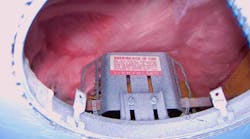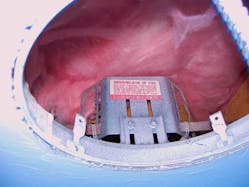How well do you know the Code? Think you can spot violations the original installer either ignored or couldn't identify? Here's your chance to moonlight as an electrical inspector and second-guess someone else's work from the safety of your living room or office. It's your turn to identify the violation.
Hint: That's not cotton candy
Find the Answer
The installer of this recessed luminaire apparently ignored the warning label on the fixture, and in doing so, ignored the rules of the NEC. The warning label clearly states to keep thermal insulation at least 3 in. away from the fixture so as not to entrap heat.
Section 110.3(B) requires equipment to be installed in accordance with any instructions in the listing or labeling. Section 410.116(B) also has a requirement to keep thermal insulation at least 3 in. away from recessed luminaires, unless the fixture is identified for insulation contact (i.e., Type IC rated). This fixture is not IC rated. When thermal insulation entraps the heat from the fixture, the excessive heat can cause the wiring to overheat and the wire insulation to become brittle. This overheating and deteriorating effect can eventually result in a fire.
I would also like to mention the Informational Note in 300.21. Many building codes and product directories have restrictions on cutting holes in fire-rated ceilings. Fixtures identified for use in fire-rated assemblies are available as well as many other protection techniques, such as installing a fire-rated box or cover around the fixture in order to maintain the fire-rating of the assembly.





